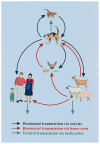Toxoplasma gondii: from animals to humans
- PMID: 11113252
- PMCID: PMC3109627
- DOI: 10.1016/s0020-7519(00)00124-7
Toxoplasma gondii: from animals to humans
Erratum in
- Int J Parasitol 2001 Feb;31(2):217-20
Abstract
Toxoplasmosis is one of the more common parasitic zoonoses world-wide. Its causative agent, Toxoplasma gondii, is a facultatively heteroxenous, polyxenous protozoon that has developed several potential routes of transmission within and between different host species. If first contracted during pregnancy, T. gondii may be transmitted vertically by tachyzoites that are passed to the foetus via the placenta. Horizontal transmission of T. gondii may involve three life-cycle stages, i.e. ingesting infectious oocysts from the environment or ingesting tissue cysts or tachyzoites which are contained in meat or primary offal (viscera) of many different animals. Transmission may also occur via tachyzoites contained in blood products, tissue transplants, or unpasteurised milk. However, it is not known which of these routes is more important epidemiologically. In the past, the consumption of raw or undercooked meat, in particular of pigs and sheep, has been regarded as a major route of transmission to humans. However, recent studies showed that the prevalence of T. gondii in meat-producing animals decreased considerably over the past 20 years in areas with intensive farm management. For example, in several countries of the European Union prevalences of T. gondii in fattening pigs are now <1%. Considering these data it is unlikely that pork is still a major source of infection for humans in these countries. However, it is likely that the major routes of transmission are different in human populations with differences in culture and eating habits. In the Americas, recent outbreaks of acute toxoplasmosis in humans have been associated with oocyst contamination of the environment. Therefore, future epidemiological studies on T. gondii infections should consider the role of oocysts as potential sources of infection for humans, and methods to monitor these are currently being developed. This review presents recent epidemiological data on T. gondii, hypotheses on the major routes of transmission to humans in different populations, and preventive measures that may reduce the risk of contracting a primary infection during pregnancy.
Figures



References
-
- Ashburn D. History and general epidemiology. In: Ho-Yen DO, Joss AWL, editors. Human toxoplasmosis. Oxford: Oxford University Press; 1992. pp. 1–25.
-
- Nicolle C, Manceaux L. Sur une infection à corps de Leishman (ou organismes voisins) du gondi. C R Hebd Séances Acad Sci. 1908;147:763–6.
-
- Nicolle C, Manceaux L. Sur un protozoaire nouveau du gondi. C R Hebd Séances Acad Sci. 1909;148:369–72.
-
- Levine ND. Taxonomy of Toxoplasma. J Protozool. 1977;24:36–41. - PubMed
-
- Tenter AM, Johnson AM. Phylogeny of the tissue cyst-forming coccidia. Adv Parasitol. 1997;39:69–139. - PubMed
Publication types
MeSH terms
Grants and funding
LinkOut - more resources
Full Text Sources
Other Literature Sources
Medical
Miscellaneous

